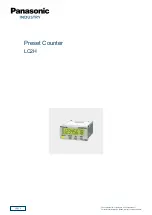
CURRENT LOOP INSTALLATION (Cont’d)
SERIAL DIP SWITCH SET-UP
The Serial DIP switches are accessible through the side of the Gemini 2000. A
list of the DIP switch positions and their functions are shown in Figure 5.
BR0 & BR1, BAUD RATE
- Set-up is shown in Figure 5, below. When
changing the Baud Rate, the unit should be powered-down and then powered
back up again. The unit will only recognize a baud rate change upon power-up,
after activating the
“Print Request”
terminal or after a few characters have
been sent at the new baud rate
(If the two previous conditions have not
occurred, the Gemini will see the characters as erroneous and it will check the
baud rate and set itself to operate at the new rate)
.
PR.ID - PRINT ID.
- When this switch is in the up position, the Gemini 2000
will print the unit address, data value ID and the data value when a
transmission is requested. The unit will also insert a 400 msec delay between
transmissions when the
“P”
command or Print Request terminal is used. This
switch position is generally used when the unit is connected with a printer.
When the switch is in the down position, the Gemini 2000 will transmit only the
data value, without the unit address and data ID. The 400 msec delay, described
above, will not be inserted. This switch position usage is intended for applications
where the Gemini is communicating with a computer. In these circumstances
printing the address and value ID and inserting a 400 msec print delay is usually
unnecessary and needlessly slows down communication throughput.
PC0 & PC1, PRINT OPTIONS
- Used to control which values are transmitted
when the Print Request terminal is activated or when the Transmit per Print
Options command
“P”
is sent to the Gemini 2000.
TRST, TRANSMIT CNT & RESET
- Used in conjunction with Print Options.
When this switch is in the down position, the unit will transmit and reset the count
whenthe
“PRINT.REQ.”
terminalisactivatedorthe
(P)
commandisreceived.
AD0, AD1, AD2 & AD3, UNIT ADDRESS
- These switches are used to give
each unit a separate address when more than one unit is connected in the Loop.
See Figure 5, for Switch Set-up.
–26–
FIG. 5: DIP SWITCH SET-UP
When connecting a printer or any
device in which the Gemini 2000’s Serial
Inputs (SI+, SI-) are not used, they must
still be connected to a 20 mA source and
be in the Mark condition (Current on) in
order for the Gemini 2000 to respond to a
Print Request.
Summary of Contents for GEMINI 1000
Page 33: ...GEMINI 1000 BLOCK DIAGRAM...
Page 34: ...GEMINI 2000 BLOCK DIAGRAM...
Page 39: ...GEMINI 1000 CONNECTIONS CONFIGURATION SWITCH SET UPS FOR VARIOUS SENSOR OUTPUTS SEE NOTE 5...
Page 40: ...GEMINI 2000 CONNECTIONS CONFIGURATION SWITCH SET UPS FOR VARIOUS SENSOR OUTPUTS SEE NOTE 5...
Page 53: ...APPENDIX F GEMINI 1000 PROGRAMMING CHART CARD...
Page 54: ...APPENDIX F GEMINI 1000 PROGRAMMING CHART CARD...
Page 55: ...APPENDIX F GEMINI 2000 PROGRAMMING CHART CARD...
Page 56: ...APPENDIX F GEMINI 2000 PROGRAMMING CHART CARD...
















































